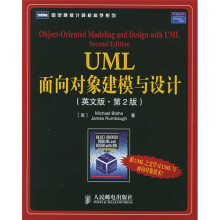UML面向对象建模与设计(英文版)(第2版)
作者:(美)巴拉赫,(美)兰宝 著
出版:人民邮电出版社 2006.1
丛书:图灵原版计算机科学系列
页数:477
定价:55.00 元
ISBN-10:7115140766
ISBN-13:9787115140760
去豆瓣看看 Chapter I Introduction
1.1 What Is Object Orientation?, 1
1.2 What Is OO Development?, 3
1.3 OO Themes, 6
1.4 Evidence for Usefulness of OO Development, 8
1.5 OO Modeling History, 9
1.6 Organization of This Book, 9
Bibliographic Notes, 10
References, 11
Exercises, 11
Part 1: Modeling Concepts
Chapter 2 Modeling as a Design Technique
2.1 Modeling, 15
2.2 Abstraction, 16
2.3 The Three Models, 16
2.4 Chapter Summary, 18
Bibliographic Notes, 19
Exercises, 19
Chapter 3 Class Modeling
3.1 Object and Class Concepts, 21
3.2 Link and Association Concepts, 27
3.3 Generalization and Inheritance, 37
3.4 A Sample Class Model, 41
3.5 Navigation of Class Models, 43
3.6 Practical Tips, 48
3.7 Chapter Summary, 49
Bibliographic Notes, 50
References, 51
Exercises, 52
Chapter 4 Advanced Class Modeling
4.1 Advanced Object and Class Concepts, 60
4.2 Association Ends, 63
4.3 N.ary Associations, 64
4.4 Aggregation, 66
4.5 Abstract Classes, 69
4.6 Multiple Inheritance, 70
4.7 Metadata, 75
4.8 Reification, 76
4.9 Constraints, 77
4.10 Derived Data, 79
4.11 Packages, 80
4.12 Practical Tips, 81
4.13 Chapter Summary, 82
Bibliographic Notes, 83
References, 83
Exercises, 83
Chapter 5 State Modeling
5.1 Events, 90
5.2 States, 92
5.3 Transitions and Conditions, 94
5.4 State Diagrams, 95
5.5 State Diagram Behavior, 99
5.6 Practical Tips, 103
5.7 Chapter Summary, 103
Bibliographic Notes, 105
References, 106
Exercises, 106
Chapter 6 Advanced State Modeling
6.1 Nested State Diagrams, 110
6.2 Nested States, 111
6.3 Signal Generalization, 114
6.4 Concurrency, 114
6.5 A Sample State Model, 118
6.6 Relation of Class and State Models, 123
……
Michael Blaha博士是加拿大温哥华Modelsoft咨询公司以及美国伊利诺伊州芝加哥SentientPoint公司的合伙人。他是IEEE计算机学会的活跃人物。他的研究兴趣包括面向对象技术、建模、系统架构、数据库设计、企业集成和反向工程。
James Rumbaug博士是IBM Rational的杰出工程师。他是UML三位首创者之一。他撰写的有关面向对象的书籍和文章在计算机界影响深远。
本书是“面向对象建模与设计”领域的经典著作,详细论述了面向对象的概念、图形表示法和开发方法学。本书由四部分组成。第一部分以一种高层的、独立于语言的方式描述面向对象的概念,还介绍了本书中使用的UML表示法;第二部分从问题陈述到分析、系统设计和类设计,一步一步地描述了软件开发的面向对象方法学;第三部分用面向对象语言和关系数据库描述了面向对象设计的实现;第四部分描述了成功的面向对象开发所需要的软件工程实践。本书还配有丰富的习题,覆盖了一系列应用领域以及实现目标,而且在书的后面给出了部分习题的答案。本书可作为高年级本科生及研究生软件工程或面向对象技术课程的教材,也可以供相关技术人员参考。
比价列表



 缺书网
缺书网 扫码进群
扫码进群
